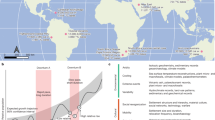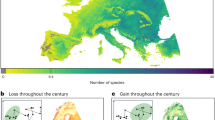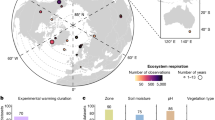Abstract
Earth's biodiversity and carbon uptake by plants, or primary productivity, are intricately interlinked, underlie many essential ecosystem processes, and depend on the interplay among environmental factors, many of which are being changed by human activities. While ecological theory generalizes across taxa and environments, most empirical tests of factors controlling diversity and productivity have been observational, single-site experiments, or meta-analyses, limiting our understanding of variation among site-level responses and tests of general mechanisms. A synthesis of results from ten years of a globally distributed, coordinated experiment, the Nutrient Network (NutNet), demonstrates that species diversity promotes ecosystem productivity and stability, and that nutrient supply and herbivory control diversity via changes in composition, including invasions of non-native species and extinction of native species. Distributed experimental networks are a powerful tool for tests and integration of multiple theories and for generating multivariate predictions about the effects of global changes on future ecosystems.
This is a preview of subscription content, access via your institution
Access options
Access Nature and 54 other Nature Portfolio journals
Get Nature+, our best-value online-access subscription
$29.99 / 30 days
cancel any time
Subscribe to this journal
Receive 12 digital issues and online access to articles
$119.00 per year
only $9.92 per issue
Buy this article
- Purchase on Springer Link
- Instant access to full article PDF
Prices may be subject to local taxes which are calculated during checkout


Similar content being viewed by others
References
Running, S. W. et al. A continuous satellite-derived measure of global terrestrial primary production. BioScience 54, 547–560 (2004).
Butchart, S. H. M. et al. Global biodiversity: indicators of recent declines. Science 328, 1164–1168 (2010).
Pan, S. et al. Modeling and monitoring terrestrial primary production in a changing global environment: toward a multiscale synthesis of observation and simulation. Adv. Meteorol. 2014, 965936 (2014).
Franklin, J., Serra-Diaz, J. M., Syphard, A. D. & Regan, H. M. Global change and terrestrial plant community dynamics. Proc. Natl Acad. Sci. USA 113, 3725–3734 (2016).
Zavaleta, E. S., Shaw, M. R., Chiariello, N. R., Mooney, H. A. & Field, C. B. Additive effects of simulated climate changes, elevated CO2, and nitrogen deposition on grassland diversity. Proc. Natl Acad. Sci. USA 100, 7650–7654 (2003).
Thornton, P. K. Livestock production: recent trends, future prospects. Phil. Trans. R. Soc. B 365, 2853–2867 (2010).
Ripple, W. J. et al. Collapse of the world's largest herbivores. Sci. Adv. 1, e1400103 (2015).
Hector, A. & Bagchi, R. Biodiversity and ecosystem multifunctionality. Nature 448, 188–190 (2007).
Worm, B. et al. Impacts of biodiversity loss on ocean ecosystem services. Science 314, 787–790 (2006).
Fraser, L. H. et al. Worldwide evidence of a unimodal relationship between productivity and plant species richness. Science 349, 302–305 (2015).
Grace, J. B. et al. Integrative modelling reveals mechanisms linking productivity and plant species richness. Nature 529, 390–393 (2016).
Adler, P. B. et al. Productivity is a poor predictor of plant species richness. Science 333, 1750–1753 (2011).
Clark, C. M. & Tilman, D. Loss of plant species after chronic low-level nitrogen deposition to prairie grasslands. Nature 451, 712–715 (2008).
Scherber, C. et al. Bottom-up effects of plant diversity on multitrophic interactions in a biodiversity experiment. Nature 468, 553–556 (2010).
Gruner, D. S. et al. A cross-system synthesis of consumer and nutrient resource control on producer biomass. Ecol. Lett. 11, 740–755 (2008).
Harpole, W. S. et al. Nutrient co-limitation of primary producer communities. Ecol. Lett. 14, 852–862 (2011).
Waide, R. B. et al. The relationship between productivity and species richness. Annu. Rev. Ecol. Syst. 30, 257–300 (1999).
Mittelbach, G. G. et al. What is the observed relationship between species richness and productivity? Ecology 82, 2381–2396 (2001).
Elser, J. J. et al. Global analysis of nitrogen and phosphorus limitation of primary producers in freshwater, marine and terrestrial ecosystems. Ecol. Lett. 10, 1135–1142 (2007).
Borer, E. T., Halpern, B. S. & Seabloom, E. W. Asymmetry in community regulation: Effects of predators and productivity. Ecology 87, 2813–2820 (2006).
Borer, E. T. et al. What determines the strength of a trophic cascade? Ecology 86, 528–537 (2005).
Hillebrand, H. et al. Consumer versus resource control of producer diversity depends on ecosystem type and producer community structure. Proc. Natl Acad. Sci. USA 104, 10904–10909 (2007).
Borer, E. T. et al. Finding generality in ecology: a model for globally distributed experiments. Methods Ecol. Evol. 5, 65–73 (2014).
Leadley, P. W. et al. Progress Towards the Aichi Biodiversity Targets: An Assessment of Biodiversity Trends, Policy Scenarios and Key Actions (Secretariat of the Convention on Biological Diversity, 2014).
Williams, J. W. & Jackson, S. T. Novel climates, no-analog communities, and ecological surprises. Front. Ecol. Environ. 5, 475–482 (2007).
Hector, A. et al. Biodiversity and ecosystem functioning: reconciling the results of experimental and observational studies. Funct. Ecol. 21, 998–1002 (2007).
Lindenmayer, D. B. et al. Value of long-term ecological studies. Austral. Ecol. 37, 745–757 (2012).
Osenberg, C. W., Sarnelle, O., Cooper, S. D. & Holt, R. D. Resolving ecological questions through meta-analysis: goals, metrics, and models. Ecology 80, 1105–1117 (1999).
Koricheva, J., Gurevitch, J. & Mengersen, K. (eds) Handbook of Meta-analysis in Ecology and Evolution (Princeton Univ. Press, 2013).
Whittaker, R. J. Meta-analyses and mega-mistakes: calling time on meta-analysis of the species richness–productivity relationship. Ecology 91, 2522–2533 (2010).
Axelrod, D. I. Rise of the grassland biome, central North America. Botan. Rev. 51, 163–201 (1985).
Foley, J. A. et al. Global consequences of land use. Science 309, 570–574 (2005).
Ellis, E. C. & Ramankutty, N. Putting people in the map: anthropogenic biomes of the world. Front. Ecol. Environ. 6, 439–447 (2008).
The PLANTS Database (USDA, NRCS, National Plant Data Team, 2016); http://plants.usda.gov
Turkington, R. Top-down and bottom-up forces in mammalian herbivore - vegetation systems: an essay review. Botany 87, 723–739 (2009).
Willig, M. R. Biodiversity and productivity. Science 333, 1709–1710 (2011).
Wardle, D. A. Do experiments exploring plant diversity–ecosystem functioning relationships inform how biodiversity loss impacts natural ecosystems? J. Veg. Sci. 27, 646–653 (2016).
Eisenhauer, N. et al. Biodiversity–ecosystem function experiments reveal the mechanisms underlying the consequences of biodiversity change in real world ecosystems. J. Veg. Sci. (2016).
Isbell, F. et al. Nutrient enrichment, biodiversity loss, and consequent declines in ecosystem productivity. Proc. Natl Acad. Sci. USA 110, 11911–11916 (2013).
Striebel, M., Behl, S. & Stibor, H. The coupling of biodiversity and productivity in phytoplankton communities: consequences for biomass stoichiometry. Ecology 90, 2025–2031 (2009).
Cardinale, B. J., Bennett, D. M., Nelson, C. E. & Gross, K. Does productivity drive diversity or vice versa? A test of the multivariate productivity-diversity hypothesis in streams. Ecology 90, 1227–1241 (2009).
Gross, K. & Cardinale, B. J. Does species richness drive community production or vice versa? Reconciling historical and contemporary paradigms in competitive communities. Am. Nat. 170, 207–220 (2007).
Hooper, D. U. et al. A global synthesis reveals biodiversity loss as a major driver of ecosystem change. Nature 486, 105–108 (2012).
Tilman, D. et al. Diversity and productivity in a long-term grassland experiment. Science 294, 843–845 (2001).
Grace, J. B. et al. Does species diversity limit productivity in natural grassland communities? Ecol. Lett. 10, 680–689 (2007).
Grace, J. B., Adler, P. B., Harpole, W. S., Borer, E. T. & Seabloom, E. W. Causal networks clarify productivity-richness interrelations, bivariate plots do not. Funct. Ecol. 28, 787–798 (2014).
Mittelbach, G. G. Understanding species richness–productivity relationships: the importance of meta-analyses. Ecology 91, 2540–2544 (2010).
Tredennick, A. T. et al. Comment on “Worldwide evidence of a unimodal relationship between productivity and plant species richness”. Science 351, 457 (2016).
Grace, J. B. et al. Response to comments on “Productivity is a poor predictor of plant species richness”. Science 335, 1441 (2012).
Fridley, J. D. et al. The invasion paradox: reconciling pattern and process in species invasions. Ecology 88, 3–17 (2007).
Sax, D. F. & Brown, J. H. The paradox of invasion. Global Ecol. Biogeogr. 9, 363–371 (2000).
Seabloom, E. W. et al. Plant species’ origin predicts dominance and response to nutrient enrichment and herbivores in global grasslands. Nat. Commun. 6, 7710 (2015).
Flores-Moreno, H. et al. Climate modifies response of non-native and native species richness to nutrient enrichment. Phil. Trans. R. Soc. Lon. B 371, 20150273 (2016).
MacDougall, A. S. et al. Anthropogenic-based regional-scale factors most consistently explain plot-level exotic diversity in grasslands. Global Ecol. Biogeogr. 23, 802–810 (2014).
Seabloom, E. W. et al. Predicting invasion in grassland ecosystems: is exotic dominance the real embarrassment of richness? Global Change Biol. 19, 3677–3687 (2013).
Cadotte, M. W. et al. Phylogenetic patterns differ for native and exotic plant communities across a richness gradient in Northern California. Divers. Distrib. 16, 892–901 (2010).
Firn, J. et al. Abundance of introduced species at home predicts abundance away in herbaceous communities. Ecol. Lett. 14, 274–281 (2011).
Rockström, J. et al. A safe operating space for humanity. Nature 461, 472–475 (2009).
Climate Change 2014: Synthesis Report (eds Core Writing Team, Pachauri, R. K. & Meyer, L. A. ) (IPCC, 2015).
Harpole, W. S. & Tilman, D. Grassland species loss resulting from reduced niche dimension. Nature 446, 791–793 (2007).
Chesson, P. Mechanisms of maintenance of species diversity. Annu. Rev. Ecol. Syst. 31, 343–366 (2000).
Grime, J. P. Competitive exclusion in herbaceous vegetation. Nature 242, 344–347 (1973).
LeBauer, D. S. & Treseder, K. K. Nitrogen limitation of net primary productivity in terrestrial ecosystems is globally distributed. Ecology 89, 371–379 (2008).
Kaspari, M. & Powers, J. S. Biogeochemistry and geographical ecology: embracing all twenty-five elements required to build organisms. Am. Nat. 188, S62–S73 (2016).
Harpole, W. S., Goldstein, L. & Aicher, R. J. in California Grasslands Ecology and Management (eds Stromberg, M. R., Corbin, J. D. & D’Antonio, C. ) Ch. 10 119–127 (Univ. California Press, 2007).
Fay, P. A. et al. Grassland productivity limited by multiple nutrients. Nat. Plants 1, 15080 (2015).
Lewandowska, A. M. et al. The influence of balanced and imbalanced resource supply on biodiversity–functioning relationship across ecosystems. Phil. Trans. R. Soc. B 371, 20150283 (2016).
Harpole, W. S. et al. Addition of multiple limiting resources reduces grassland diversity. Nature 537, 93–96 (2016).
Prober, S. M. et al. Plant diversity predicts beta but not alpha diversity of soil microbes across grasslands worldwide. Ecol. Lett. 18, 85–95 (2015).
Hautier, Y. et al. Eutrophication weakens stabilizing effects of diversity in natural grasslands. Nature 508, 521–525 (2014).
Morgan, J. W. et al. Species origin affects the rate of response to inter-annual growing season precipitation and nutrient addition in four Australian native grasslands. J. Veg. Sci. 27, 1164–1176 (2016).
Stevens, C. J. et al. Anthropogenic nitrogen deposition predicts local grassland primary production worldwide. Ecology 96, 1459–1465 (2015).
O’Halloran, L. R. et al. Regional contingencies in the relationship between aboveground biomass and litter in the world's grasslands. PLoS ONE 8, e54988 (2013).
Tilman, D. Resource Competition and Community Structure. (Princeton Univ. Press, 1982).
Tilman, D. The resource-ratio hypothesis of plant succession. Am. Nat. 125, 827–852 (1985).
Huisman, J. & Weissing, F. J. Light-limited growth and competition for light in well-mixed aquatic environments - an elementary model. Ecology 75, 507–520 (1994).
Borer, E. T. et al. Herbivores and nutrients control grassland plant diversity via light limitation. Nature 508, 517–520 (2014).
La Pierre, K. J., Blumenthal, D. M., Brown, C. S., Klein, J. A. & Smith, M. D. Drivers of variation in aboveground net primary productivity and plant community composition differ across a broad precipitation gradient. Ecosystems 19, 521–533 (2016).
Leff, J. W. et al. Consistent responses of soil microbial communities to elevated nutrient inputs in grasslands across the globe. Proc. Natl Acad. Sci. USA 112, 10967–10972 (2015).
Hunter, M. D. & Price, P. W. Playing chutes and ladders - heterogeneity and the relative roles of bottom-up and top-down forces in natural communities. Ecology 73, 724–732 (1992).
Polis, G. A. & Strong, D. R. Food web complexity and community dynamics. Am. Nat. 147, 813–846 (1996).
Cebrian, J. et al. Producer nutritional quality controls ecosystem trophic structure. PLoS ONE 4 e4929 (2009).
Viola, D. V. et al. Competition–defense tradeoffs and the maintenance of plant diversity. Proc. Natl Acad. Sci. USA 107, 17217–17222 (2010).
Lind, E. M. et al. Life-history constraints in grassland plant species: a growth-defence trade-off is the norm. Ecol. Lett. 16, 513–521 (2013).
Hautier, Y., Niklaus, P. A. & Hector, A. Competition for light causes plant biodiversity loss after eutrophication. Science 324, 636–638 (2009).
Knapp, A. K. et al. Past, present, and future roles of long-term experiments in the LTER network. BioScience 62, 377–389 (2012).
Dodds, W. K. et al. Surprises and insights from long-term aquatic data sets and experiments. BioScience 62, 709–721 (2012).
Bonan, G. B., Hartman, M. D., Parton, W. J. & Wieder, W. R. Evaluating litter decomposition in earth system models with long-term litterbag experiments: an example using the Community Land Model version 4 (CLM4). Global Change Biol. 19, 957–974 (2013).
Suddick, E. C., Whitney, P., Townsend, A. R. & Davidson, E. A. The role of nitrogen in climate change and the impacts of nitrogen–climate interactions in the United States: foreword to thematic issue. Biogeochemistry 114, 1–10 (2013).
Acknowledgements
We thank each of the researchers who have contributed data and ideas to the Nutrient Network (http://www.nutnet.org), Supplementary Table 1 lists contributing sites (2007–2016). Grants to E.T.B. and E.W.S. from the National Science Foundation (NSF-DEB-1042132, NSF-DEB-1234162), and the Institute on the Environment (DG-0001-13) supported parts of this work. J.B.G. was supported by the USGS Ecosystems and Climate and Land Use Change programmes.
Author information
Authors and Affiliations
Contributions
E.T.B. conceived and drafted the manuscript; J.B.G., W.S.H., A.S.M. and E.W.S. contributed to writing.
Corresponding author
Ethics declarations
Competing interests
The authors declare no competing financial interests.
Supplementary information
Supplementary Information
List of Nutrient Network contributing sites. (PDF 248 kb)
Rights and permissions
About this article
Cite this article
Borer, E., Grace, J., Harpole, W. et al. A decade of insights into grassland ecosystem responses to global environmental change. Nat Ecol Evol 1, 0118 (2017). https://doi.org/10.1038/s41559-017-0118
Received:
Accepted:
Published:
DOI: https://doi.org/10.1038/s41559-017-0118
This article is cited by
-
Globally consistent response of plant microbiome diversity across hosts and continents to soil nutrients and herbivores
Nature Communications (2023)
-
Nitrogen addition and fungal symbiosis alter early dune plant succession
Oecologia (2023)
-
The synergistic response of primary production in grasslands to combined nitrogen and phosphorus addition is caused by increased nutrient uptake and retention
Plant and Soil (2023)
-
Bermudagrass “Tifton 85” sazonality production during the year with and non-irrigated up different doses nitrogenadas in southern of Brazil
Arabian Journal of Geosciences (2023)
-
Multidimensional responses of grassland stability to eutrophication
Nature Communications (2023)



